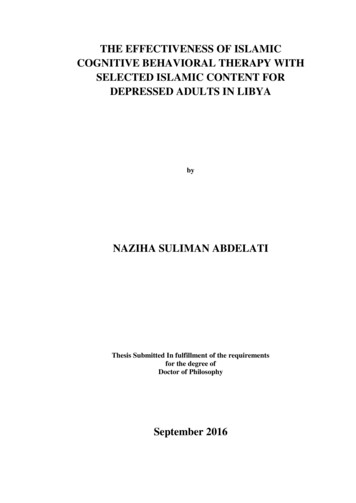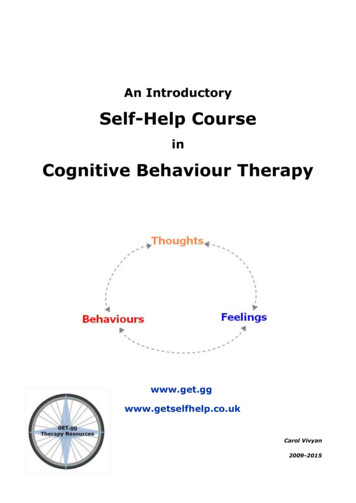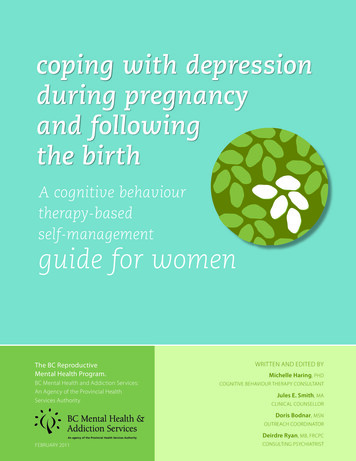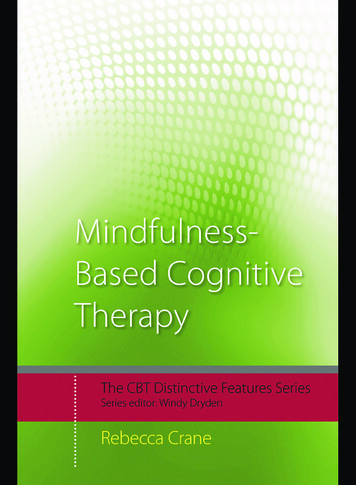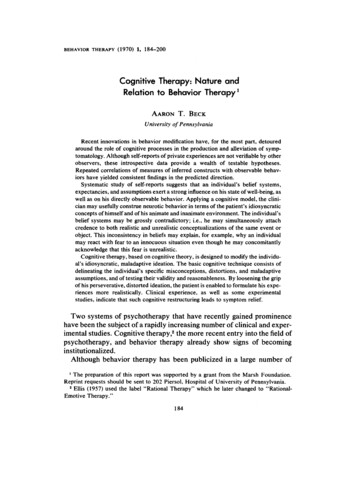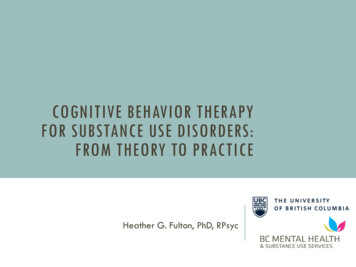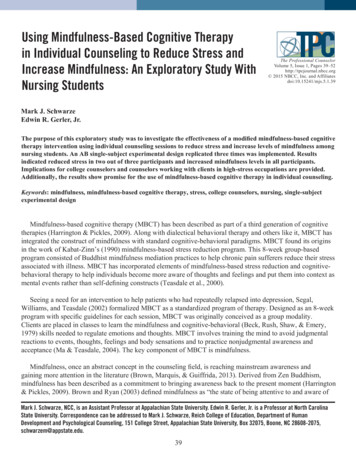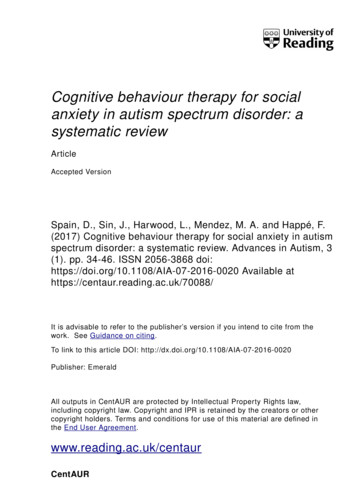
Transcription
Cognitive behaviour therapy for socialanxiety in autism spectrum disorder: asystematic reviewArticleAccepted VersionSpain, D., Sin, J., Harwood, L., Mendez, M. A. and Happé, F.(2017) Cognitive behaviour therapy for social anxiety in autismspectrum disorder: a systematic review. Advances in Autism, 3(1). pp. 34-46. ISSN 2056-3868 doi:https://doi.org/10.1108/AIA-07-2016-0020 Available athttps://centaur.reading.ac.uk/70088/It is advisable to refer to the publisher’s version if you intend to cite from thework. See Guidance on citing .To link to this article DOI: r: EmeraldAll outputs in CentAUR are protected by Intellectual Property Rights law,including copyright law. Copyright and IPR is retained by the creators or othercopyright holders. Terms and conditions for use of this material are defined inthe End User Agreement .www.reading.ac.uk/centaurCentAUR
Central Archive at the University of ReadingReading’s research outputs online
CBT for social anxiety in ASDAuthors’ detailsDebbie Spainab, Jacqueline Sinac, Laura Harwood, Andreina Mendeza and Francesca Happéaa. Institute of Psychiatry, Psychology & Neuroscience, King’s College Londonb. South London & Maudsley NHS Foundation Trustc. St George’s, University of LondonCorrespondence detailsDebbie SpainAddress: MRC Social, Genetic and Developmental Psychiatry Centre, Institute of Psychiatry,Psychology & Neuroscience, King’s College London, de Crespigny Park, PO Box 80,London, SE5 8AF, UKTelephone: 00 44 207 848 5388Fax: 00 44 207 848 0650Email: nts to Kai B Linder who provided support with manuscript preparation. DS isfunded by a National Institute for Health Research (NIHR) Clinical Doctoral ResearchFellowship (CDRF–2012–03-059). JS is supported by a NIHR Post Doctoral ResearchFellowship (reference PDF-2015-08-035, 2016-2020), and also in part by the NIHRBiomedical Research Centre based at Guy’s and St Thomas’ NHS Foundation Trust andKing’s College London (2015-2017).This paper presents independent research funded by the NIHR. The views expressed are thoseof the authors and not necessarily those of the NHS, the NIHR, or the Department of Health.
CBT for social anxiety in ASDCognitive behaviour therapy for social anxiety in autism spectrum disorder:A systematic reviewAbstractPurpose: Individuals who have autism spectrum disorders (ASD) commonly experienceanxiety about social interaction and social situations. Cognitive behaviour therapy (CBT) is arecommended treatment for social anxiety (SA) in the non-ASD population. Therapytypically comprises cognitive interventions, imagery-based work and for some individuals,behavioural interventions. Whether these are useful for the ASD population is unclear.Therefore, we undertook a systematic review to summarise research about CBT for SA inASD.Approach: Using a priori criteria, we searched for English-language peer-reviewed empiricalstudies in five databases. The search yielded 1364 results. Titles, abstracts and relevantpublications were independently screened by two reviewers.Findings: Four single case studies met the review inclusion criteria; data were synthesisednarratively. Participants (three adults and one child) were diagnosed with ASD and socialanxiety disorder. There were commonalities in interventions and techniques used:participants were encouraged to identify and challenge negative thoughts, enter anxietyprovoking social situations, and develop new ways of coping. Unlike CBT for SA in nonASD individuals, treatment also included social skills interventions. Outcomes were assessedusing self- or informant-reports. Improvements in social anxiety and depressive symptoms,social skills, and activity levels were noted. Generalisability of results is hampered, however,by the small number of studies and participants, and lack of randomised controlled trial(RCT) conditions employed.Research implications: Future studies should investigate how beliefs and behavioursindicative of SA can be ameliorated in individuals with ASD.Originality: This is the first review to synthesise empirical data about CBT for SA in ASD.
CBT for social anxiety in ASDKeywords: Autism spectrum disorder (ASD), Asperger syndrome, Social anxiety, Socialphobia, Cognitive behaviour therapy (CBT)IntroductionAnxiety and worry about social situations are common experiences for individuals withautism spectrum disorders (ASD). Although the assessment of social anxiety (SA) can provecomplex due to diagnostic overlapping and overshadowing, data obtained fromepidemiological and clinical samples indicate that up to 50% of young people and adults withASD have clinically significant SA symptoms (Bellini, 2004; Maddox and White, 2015;Spain et al., 2016a); rates that far exceed population norms (NICE; 2013). Of note, manystudies investigating SA in ASD samples focus more intently on affective and behaviouralsymptoms rather than the social-evaluative concerns or fears of negative evaluation, whichare characteristic of SA.Causal and maintaining mechanisms for SA likely include a combination of genetic,psychological, and social factors (e.g. Bellini, 2006; NICE, 2013; Morrison and Heimberg,2013; White et al., 2009).For example, individuals with ASD may have a geneticvulnerability for anxiety (e.g. Tick et al., 2016), as well as a predisposition for behaviouralinhibition. Also, innate difficulties with interaction and communication conceivably impacton social situations and relationships. Impairments in the ability to recognise and understandothers’ mental states (Baron-Cohen et al., 2001) may give rise to problematic interactions,and thus potentially contribute to the development of negative beliefs about the self, e.g.about difference or inferiority, and also, perceived ability to react and respond appropriatelyduring social interactions. It is feasible that peer rejection, bullying, and ostracism duringchildhood and adolescence (Schroeder et al., 2014) reinforce these negative beliefs andencourage social withdrawal and isolation; factors that can precipitate and perpetuate SA.Further, the cognitive style associated with ASD, such as perseveration, rumination, and atendency for focusing on specific details rather than ‘the bigger picture’ (also known as weakcentral coherence; Brunsdon and Happé, 2015) may mean that it is more difficult forindividuals to ignore or rationalise negative automatic thoughts which occur before, during,or after social interactions. Similarly, impairments or biases in memory, attention, emotion,or information processing, may encourage rumination or safety behaviours, such as mentalrehearsal, an inward focus (seeing oneself as a social object), or post-event processing (e.g.Clark, 1999; Morrison and Heimberg, 2013; Rapee and Heimberg, 1997). Finally,
CBT for social anxiety in ASDpreferences for routinised activities and sensory aversions (WHO, 1992) may perpetuate orexacerbate avoidance of general or specific social situations.In the non-ASD population, there is increasing evidence to suggest that cognitive therapy andcognitive behaviour therapy (CBT), delivered via individual, group-based or onlineplatforms, are effective psychological interventions for reducing SA symptoms (e.g. Carlbinget al., 2009; Hedman et al., 2011; NICE, 2013). CBT is a type of talking therapy thatinvolves exploring the ways in which early life experiences or critical events can affect theway that people think about themselves and others, how they feel, and how they cope.Treatment involves supporting individuals to develop new ways of thinking about, andreacting or responding to situations, with a view to reducing negative affect, and enhancingself-efficacy (Kennerley and Westbrook, 2011).CBT for SA shares similarities with CBT for other anxiety disorders. Treatment typicallyinvolves weighing up and testing out the accuracy of negative thoughts and beliefs,identifying more neutral explanations for the manifestation of autonomic symptoms, andtrying new ways of managing and coping. There are, however, some elements of treatmentthat are specific to SA. These include an emphasis on learning to shift attentional focus frominternal states to external stimuli, and imagery rescripting in order to address traumaticmemories about, and arising from, adverse or aversive social interactions. Overall, cognitiveinterventions are deemed critical for the success of treatment, more so than behaviouraltechniques (Clark, 1999; NICE, 2013).Recent systematic reviews demonstrate that anxiety and affective symptoms can beameliorated in individuals with ASD, following a course of CBT (Lang et al., 2010; Spain etal., 2015). With few exceptions, studies to date have investigated the effectiveness of CBTfor transdiagnostic constructs and processes (such as anxiety or avoidance), rather thanspecific disorders. While there is some evidence to suggest that transdiagnostic interventionshave clinical utility, a recent meta-analysis by Anderson and colleagues (2016) concludedthat the effects of these approaches may be ‘inflated’ and overestimated. Also, treatmentmanuals used in CBT studies for the ASD population seem to favour behaviouralinterventions. While it may be that this clinical population experiences difficulty with usingcognitive techniques e.g. due to alexithymia (difficulties identifying own emotions; Bird andCook, 2013), findings from empirical research indicate that these techniques can be useful
CBT for social anxiety in ASD(Lang et al., 2010; Spain et al., 2015). Given that there are unique mechanisms which arehypothesised to maintain SA – such as self-focused attention and post-event processingwhich are typically targeted by cognitive techniques, it is important to understand whether 1)individuals with ASD can derive benefit from CBT for SA, 2) which techniques are usedduring treatment, and 3) how the structure or content of therapy is modified, if at all, toaccommodate either core ASD or associated difficulties. This systematic review sought tosummarise the empirical literature about CBT for SA in ASD.MethodsSearch strategy: We searched for English-language peer-reviewed publications in fivedatabases: PubMed, Medline, PsycINFO, Web of Science and CENTRAL (Cochrane CentralRegister of Controlled Trials). We searched for studies published from the date of inceptionuntil 31 May, 2016. Search terms included autis* - Asperger* - develop* dis* AND socialanx* - social phobi*. There was no stipulation about the types of comparator interventions ormethods of outcome measurement, in order to maximise the search sensitivity.Inclusion criteria: Our a priori inclusion criteria were 1) empirical studies, 2) describingcognitive, behavioural or CBT interventions, 3) specifically designed to address symptoms ofSA, social anxiety disorder or social phobia, 4) offered via any modality, 5) for children,adolescents or adults diagnosed with any sub-type of ASD, and 6) which assessed symptomsat least once pre- and post-intervention.Exclusion criteria: We excluded 1) grey literature, 2) pure social skills interventions (becausethese are neither specifically designed to target beliefs associated with negative evaluationnor are they necessarily intended to target anxiety about social situations), and 3) CBTinterventions targeting general mental health symptoms, rather than SA symptomsspecifically.Study selection: See Figure 1 for an overview of the search process. The search initiallyyielded 1363 results, and 163 duplicates were removed at this stage. The remaining 1200titles and abstracts were reviewed independently by two reviewers (DS and JS). Of these, 22full-text papers were retrieved for further scrutiny. Nineteen studies were excluded, as thesewere reviews or intervention studies which did not meet the a priori criteria. One additionalstudy was retrieved following a handsearch. Hence, four studies met the review inclusion
CBT for social anxiety in ASDcriteria (Cardaccioto and Herbert, 2004; Schleismann and Gillis, 2011; Turner andHammond, 2016; Wright, 2013) (See Table 1).Analysis plan: As there were a limited number of studies included, all of which were singlecase reports, we synthesised data using a narrative approach.FindingsOverview of studies: Two case studies were undertaken in the UK (Turner and Hammond,2016; Wright, 2013), and two in the US (Cardaccioto and Herbert, 2004; Schleismann andGillis, 2011).Participants: Participants were four males: two adults with Asperger syndrome, one adultwith ASD and an intellectual disability (ID), and one child with Asperger syndrome. Allparticipants were also reported to have social anxiety disorder. Additionally, all three adultswere considered to have clinically significant symptoms of depression.Quality assessment: We did not formally assess the methodological quality of studiesincluded, given that these were N 1 designs.Referral routes to CBT: Limited information was available about the study sampling frames.As such, it was unclear whether participants were representative of individuals referred to therespective clinical services. Nonetheless, it was noted that in all cases, participants had selfreferred or a significant other (such as a parent) had requested psychological input.Treatment modality: All participants were offered individual sessions, albeit that in onestudy, parent-training was offered as an adjunct to these sessions (Schleismann and Gillis,2011).Intervention aims: The intervention aims were similar across studies. The intention was toimprove social skills, reduce anxiety about and avoidance of social situations, and in onecase, enhance self-esteem (Turner and Hammond, 2016), and in another, augmentemployment skills (Cardaccioto and Herbert, 2004).
CBT for social anxiety in ASDCBT case conceptualisations: Social anxiety-specific formulations were used in two studies(Cardaccioto and Herbert, 2004; Turner and Hammond, 2016). The study by Schleismannand Gillis (2011) was informed by ‘The Coping Cat’ model (Kendall, 1992); a commonlyused, generic framework for helping young people to understand and overcome anxiety. Inthree studies, both longitudinal formulations as well as maintenance cycles were devised withparticipants, to aid with the development of a shared understanding of the links betweenevents, thinking styles and thoughts, feelings and emotions, and behaviours (Cardaccioto andHerbert, 2004; Turner and Hammond, 2016; Wright, 2013). Finally, in one study, an ASDspecific framework (Gaus, 2011) was referred to in order to outline potential relationshipsbetween ASD characteristics, neuropsychological processes, and presenting difficulties.Interventions and techniques: There were commonalities in terms of the interventions andtechniques employed across studies. All participants were initially offered psychoeducationabout anxiety, and in some cases, about social skills. In three studies, participants wereoffered social skills interventions early on; a deviation from standard CBT for SA protocols(NICE, 2013). Role play and role modelling were prominent components of each study.Similarly, there was an emphasis on skills rehearsal during sessions. All participants wereencouraged to develop a hierarchy of anxiety-provoking or avoided situations, which wasused to inform in vivo tasks. It is implied that these tasks involved exposure, i.e. abehavioural intervention primarily introduced to help individuals habituate to anxioussituations. Also, it is suggested that these hierarchies may have been used as a basis forbehavioural experiments, i.e. cognitive interventions that facilitate the ‘testing out’ of thestrength of (negative) beliefs, e.g. about social situations or social performance. Cognitiveinterventions were introduced in three studies, which involved participants learning toidentify negative automatic thoughts or schema, and developing ways of challenging theseeither through cognitive restructuring or positive self-talk techniques. In one study, attentiontechniques were utilised in order to encourage a shift from focusing on internal stimuli toexternal cues. Finally, one individual was taught relaxation techniques. Of note, there was nomention of imagery-based work; a common component of CBT for SA in non-ASDindividuals.Parent-training: In one study, parents were involved in treatment as parent-trainers ratherthan parents-as-patients. This was in order to support the individual to practice techniquesand skills acquired outside of therapy sessions, and to enhance “appropriate extinction of
CBT for social anxiety in ASDavoidance behaviours, [and] reinforcement of approach behaviours” (Schleismann and Gillis,2011, p. 520).Homework: All participants were asked to complete homework tasks between sessions. Tasksprimarily involved exposure, increasing activity levels, behavioural experiments, and beliefwork. No data were available about the proportion of homework tasks completed, or whetherparticipants were more likely to engage in behavioural or cognitive tasks outside of sessions.Treatment duration: The duration of treatment was 11-15 sessions. Where reported, sessionslasted for 60 minutes. It is not known whether participants were offered breaks.Modifications: It appears that several modifications were made to the standard structure andcontent of CBT for SA, seemingly to accommodate the needs that individuals with ASD (andpotentially ID) have (Anderson and Morris, 2006; Attwood, 2004). Modifications includedextra sessions of psycho-education, detailed information about abstract concepts (e.g.anxiety), use of visual aids (e.g. cue cards and prompts to demarcate activities duringsessions), inclusion of social skills sessions, modelling of ‘appropriate’ social skills bytherapists, numerous opportunities for skills rehearsal, and introduction of positive self-talkand coping statements. What is less clear is which modifications may have been introduced toaccommodate difficulties associated with a concurrent ID (rather than ASD characteristics).Outcome measurement: Outcome measures included self- and informant-ratings of SA,mental health, general functioning, and behavioural assessment, completed at least pre- andpost-treatment. SA was measured using a clinician-administered interview (the StructuredClinical Interview for Disorders – IV), or standardised questionnaires, including theLiebowitz Social Anxiety Scale (LSAS; Liebowitz, 1987), Social Phobia and AnxietyInventory (SPAI; Turner, Beidel, Dancu and Stanley, 1989), Social Phobia Weekly SummaryScale (SPWSS; Clark et al., 2003), Revised Children’s Manifest Anxiety Scale (RCMAS;Reynolds and Richmond, 2008), and the Fear Survey Schedule (FSS; Ollendick, 1983). Inthree studies, mental health was measured using the Beck Depression Inventory II (BDI;Beck, 1996), Rosenberg Self-Esteem Scale (RSE; Rosenberg, 1965), or the Brief SymptomInventory (BSI; Derogatis, 1975). Of note, none of the self-report questionnaires have beenvalidated for either the ASD or the ID population. General functioning was assessed using theClinical Global Impression Scale (CGI; NIH, 1985), Vineland Adaptive Behaviour Scales II
CBT for social anxiety in ASD(VABS; Sparrow, Cicchetti and Ballar, 2005), and the Clinical Outcomes in RoutineEvaluation Measure (CORE-OM; Evans et al., 2000). Finally, role play tasks were used toassess behaviour in one study, whereas a second study used the Behaviour AssessmentSystem for Children II-Parent Rating Scales (BASC; Reynolds and Kamphaus, 2004).Treatment effectiveness: Results reported for each study indicated that participants seemed toderive benefit from treatment. Self-reported SA symptoms improved: participants endorsedfewer anxiety symptoms, less concern about social interactions or performance, and overall,they engaged in a wider range of social situations more frequently. Additionally, it was notedthat depressive symptoms improved: participants, on average, endorsed fewer symptomsindicative of depression post-intervention. In terms of general mental health and well-being,scores on the CGI and CORE-OM shifted from the severe to the mid-range or milder end ofthe spectrum. As measured in one study, self-esteem was enhanced following CBT. Finally,observed social skills changed during the course of treatment, whereby participants werereported to use better verbal and non-verbal communication skills.DiscussionA significant proportion of young people and adults with ASD feel socially anxious, and wesought to summarise published empirical data about CBT for SA in this population. Using apriori criteria and a fairly rigorous search process, four single case studies met the reviewcriteria. Treatment in each involved behavioural and in most cases, cognitive interventions.These were principally designed to reduce negative affect, encourage identification of newways of managing in and coping with social situations, and address unhelpful thoughts andbeliefs. Additionally, social skills interventions were offered to three participants. Overall,improvements in SA, mental health (including low mood and paranoia), and generalfunctioning were reported across studies, primarily on self- or informant-rating scales. Also,there was some indication that participants had a wider repertoire of adaptive strategies postintervention. Findings synthesised here, albeit relating to a very small and select sample, areconsistent with those reported in other studies; that is, individuals with ASD can derivebenefit from both behavioural and cognitive interventions for anxiety symptoms (Kreslins etal., 2015; Lang et al., 2010; Spain et al., 2015).It is evident that participants were offered components of standard CBT for SA protocols(NICE, 2013). For example, a fundamental aspect of CBT involves the identification and
CBT for social anxiety in ASDrationalisation of negative automatic thoughts and beliefs (Kennerley and Westbrook, 2011).Despite potential concerns that individuals with ASD may struggle to use cognitivetechniques, the findings described here suggest that this clinical population may find theseinterventions accessible, albeit that additional preparatory work may be necessary, such as toaddress emotional literacy. Additionally, some participants collaboratively developed ahierarchy of difficult situations, and engaged in exposure or experimentation. The ease withwhich participants were able to generate a hierarchy of situations is not comprehensivelyoutlined. However, given hypothesised impairments in executive functioning (e.g. Hill,2004), participants may have required more support with this than might be expected. Whileattention training and imagery-based work are deemed to be useful ways of addressing SA(NICE, 2013), none of the participants in these studies appear to have been offered imagerytechniques, and attention training featured minimally. Why these interventions were notoffered is not fully described. It may be, for example, that these interventions are morecomplex to understand, or they may not be required when working with this population.Generalisability of study findings: The degree to which study results are generalisable to thewider ASD population remains to be seen, particularly given that there were limited dataavailable about referral routes for CBT, all participants were male, and more importantly,each study used an N 1 design. Nevertheless, publication of case reports is an importantmeans of outlining innovations in clinical practice or the application of standard interventionsto novel populations.Limitations: We acknowledge that this review has several limitations. First, we solelyincluded English-language publications. Given that there may be cultural factors associatedwith SA, omission of non-English language studies may mean that the review findings areonly applicable to people living in Western cultures. Second, we deliberately excluded CBTinterventions designed to target transdiagnostic beliefs and behaviours associated with arange of anxiety disorders. While we did so on the basis that there are unique maintainingmechanisms for SA, an alternative approach could have been to adopt a wider search remit soas to compare the relative effectiveness of interventions for general versus specific anxietysymptoms/disorders. Finally, we did not contact trialists working in the field, who may beaware of studies in press.
CBT for social anxiety in ASDClinical implications: It is encouraging that participants in studies described here derivedbenefit from interventions, as assessed by self- or informant-rated measures. Based on thesecase reports and the wider ASD literature, we propose that there are several implications forclinical practice.First, it is quite likely that individuals who have both ASD and SA will find it difficult tospontaneously seek help and disclose their symptoms, given that they are likely to beconcerned about negative evaluation (Kreiser and White, 2014). Also, SA symptoms may belong-standing and therefore not easily differentiated from the core disorder (e.g. due todiagnostic overshadowing) (Tyson and Cruess, 2012). The implication is that clinicians mayneed to be proactive in assessing symptoms. While studies reviewed included a relativelyshort assessment phase, we suggest that assessment and information-gathering may need tobe the focus of several sessions, for example, to help individuals to habituate to the therapistand therapy process (e.g. Spain et al., 2016b).Second, study formulations included longitudinal and cross-sectional models; not all of whichwere (SA) disorder-specific. In clinical practice, it may be appropriate to start ‘socialising’individuals using simple maintenance cycles (Anderson and Morris, 2006; Gaus, 2011), suchas those that include thoughts, feelings and behavioural responses. This is potentially lessoverwhelming, may offset information processing deficits, and the process may offer aninsight into the emotional literacy of individuals. The use of disorder-specific formulationsmay be appropriate for some individuals.Third, participants in each case study were encouraged to develop a hierarchy of difficultsituations, which informed ensuing interventions. Of note, some individuals with ASD mayfind it hard to identify goals they would like to work towards, because this relies on a degreeof abstract thought, or because the idea of change is uncomfortable (WHO, 1992). Toovercome this potential obstacle, it may be useful for clinicians to suggest possible goals, orto spend several sessions exploring these.Fourth, the number of sessions attended ranged from 11 to 15, approximately similar to CBTfor SA in the non-ASD population (NICE, 2013). While it is encouraging that participantswere able to effect change in the short term, and during a reasonably short period, it has beensuggested elsewhere that this clinical population conceivably benefits from a protracted
CBT for social anxiety in ASDperiod of treatment (Walters et al., 2016). We suggest therefore, that clinicians consider whatmight be an optimal number of sessions, potentially in consultation with clinical supervisorsor line managers. Moreover, the duration of therapy is likely contingent on the goals fortreatment, as well as possible service constraints. Equally, where reported, sessions lastedaround 60 minutes, and it is unclear whether the session duration was decided based onindividual preference or other factors. Whether participants were offered a break is notwholly clear. In clinical practice, it may be worth clarifying with patients whether they wishto have a break during a session, and for there to be a discussion about whether shorter orlonger sessions are preferred (Attwood, 2004; Gaus, 2011). This is particularly importantwhen addressing SA symptoms such as via behavioural experimentation outside of thetherapist’s room.Fifth, there were commonalities and differences in interventions utilised across studies. Acardinal component was social skills interventions, which is not included in standard CBTprotocols for SA. This raises a question about whether SA in ASD is underpinned byimpairments in social skills, unlike SA in other populations (Morrison and Heimberg, 2013;Rapee and Heimberg, 1997). Clinicians may need to be pragmatic about whether to includesocial skills work. For example, such interventions may be necessary in order to thenintroduce in vivo exposure. Conversely, individuals with ASD and SA may have relativelygood social skills, but underestimate their capacity and capabilities, thereby implying thatcognitive interventions may be useful. Additionally, imagery-based work was notincorporated in studies, yet there is some empirical literature to suggest that negative imagerymay be a maintaining mechanism for anxiety disorders, and SA in particular (Wild and Clark,2011). Few studies have investigated imagery in ASD samples (Ozsivadjian et al., 2016), butin keeping with the hypothesis that individuals with ASD are ‘visual thinkers’ (Kunda andGoel, 2011), imagery may either be a causal or maintaining factor for negative affect. Acautious approach may be needed when undertaking imagery work with this group, and soclinical supervision may be a forum within which to discuss whether these techniques arenecessary for ameliorating SA in this group. In one study, parent-training was offered as anadjunct to therapy (Schleismann and Gillis, 2011). While this study pertained to a child,adults with ASD may also benefit from support outside of sessions, in order to aid with thegeneralisation of skills and techniques acquired, and so as to ‘test out’ techniques in ‘realworld’ situations.
CBT for social anxiety in ASDFinally, studies primarily relied on self-ratings of psychopathology symptoms and generalfunctioning. It is usual to ask individuals to provide a subjective account of change, but thevalidity and reliability of self-report
Cognitive behaviour therapy for social anxiety in autism spectrum disorder: a systematic review Article Accepted Version Spain, D., Sin, J., Harwood, L., Mendez, M. A. and Happé, F. (2017) Cognitive behaviour therapy for social anxiety in autism spectrum disorder: a systematic review. Advances in Autism, 3 (1). pp. 34-46. ISSN 2056-3868 doi:

